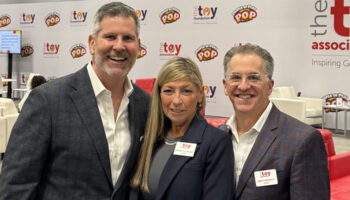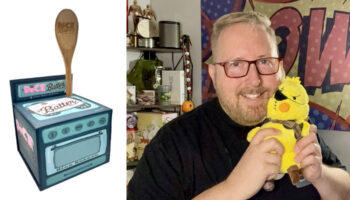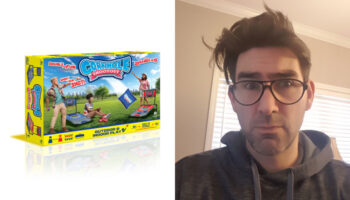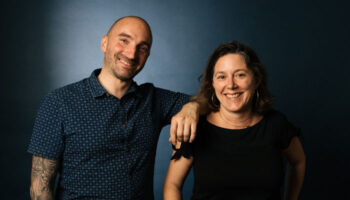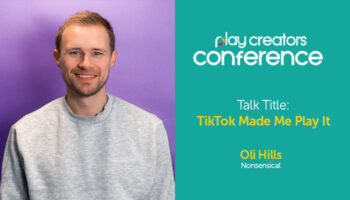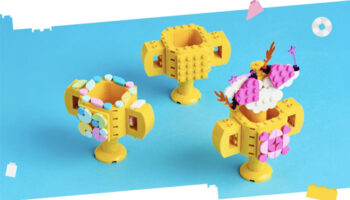JMP Creative’s Jim McCafferty reveals how brainstorming, magic and a thick skin power his creativity

With a past career as an escapologist and illusionist, Jim McCafferty now makes the world a happier place by creating magical toys and games… And terrific entertainment.
With recent category-spanning success stories including the likes of Asmodee’s Dobble 360, Hasbro’s Zoops range and the Crayola Glitter Dots line, we caught up with Jim to learn more about why magic remains a key ingredient when it comes to the firm’s inventions.

Thanks for making time for us Jim… You’ve been on our wish list for ages! Let’s start with the obvious: you’re the President-CEO of JMP Creative… What is that?
It’s a highly-talented group of people that creates ‘wow’ moments for consumers of all ages! Our Magic Workshop is filled with dreamers, designers, prototype builders, inventors, storytellers, artists, videographers and performers.
Sounds amazing. What is it you do, specifically?
My core role is to provide ideas, direction and strategy for the team and most-trusted partners. I help provide feedback based on the ‘North Star’ for each opportunity and then provide a pivot when we discover unexpected magic that takes us on a new course…
Once we’ve created the magic and a dynamic position, I frequently play a role in presentations distributed to our favourite friends in the toy and promotional worlds. In addition, I continually add magical elements within our crazy workshop to inspire all who enter the facility.
The word crazy’s well chosen! What expectations are you managing by having, say, a life-size U.F.O. for office meetings? What do you want people to think about JMP Creative?
We have a very-simple business model here: invent and have fun, make money to invent – and have fun again… It’s like the shampoo bottle adverts: rinse and repeat! And if someone doesn’t have fun when they visit our world, they’re probably not the right company for us to play with! So I want people that need a product, or social-media program with magic, to think: “Let’s go see Jim and his amazing team at their Magic Workshop.”

You use the word magic a lot. That’s an important part of your background, is it not?
Yes; my background is from the world of magic. I used to perform here and there. Then I began working with agencies to infuse magic and illusion in their marketing programs. This meant facilitating brainstorming sessions for some of the top brands in the world, before offering promotional services for clients such as Pepsi, Frito-Lay and 7-Eleven.
Okay. In my experience, a great deal of brainstorming is just woeful. What do you do differently in your ‘Nitro Sessions’, as you a call them?
Wow, this is a BIG TOPIC – lots of rabbit holes to go down!
Well… It’s a web page, I don’t think there’s a limit on the word count!
Great! I could go on for days! First, I think we’re all guilty of “squeezing out” an idea during a high-speed brain drain… When time allows, though, we prefer to work with our partners far more strategically.
To start, we aim to get the obvious answers on a video wall for all to see prior to the session. We use that as a springboard to the next level of ideas. It’s VERY IMPORTANT to conduct prep work before starting to define the “Right Questions”… So when we conduct with partners, we strive to prepare games and unique stimuli in developing ideas.
So to be clear: you get obvious ideas ahead of the session, and share them in advance. You do a lot of prep, then take stimuli to the actual meeting. What kind of stimuli?
Anything that helps people think differently! Over the years I’ve used everything: puppies, alligators, weird foods, stuntmen, cheerleading Laker Girls, Taiko drummers, X Games athletes, mermaids, monkeys and more! Whatever it takes! My goal is to get people’s creative adrenalin going, and get them to think from many different perspectives. A hug from a monkey can do that.
I don’t doubt it! How big are these meetings?
It varies. For large sessions, I break the attendees up into smaller teams which shift and change throughout the activities. We then use fun exercises and unique, inspirational tools to get people out of their comfort zone and away from the obvious!
Another thing we do differently is reserve quiet, personal thinking time during a session. Constant group talk typically fails for effective thinking. We also encourage no shortage of kit bashing as there are always plenty of crafty supplies to form or simulate an idea.
So the advance prep and intermittent quiet time help address, presumably, the problem of not priming and engaging the unconscious mind?
Yes – it’s extremely important to have the right mix of personal “think time” in the exercises… Several activities are designed for everyone to quietly get into their own heads and explore ideas without collaboration. After they record these ideas, they transition to group discussions to riff with each other. Each participant writes all concepts on prepared idea sheets, or they doodle concepts onto tablets we provide.
This sounds incredible!
That’s a portion of the process… In the end, we export all the concepts to the video wall. That way, we can see every idea which was recorded and perform a larger review before idea mining to find the best concept.
Brilliant! And you know what? That was an aside; I totally diverted you: you were saying that you started offering promotional services to Pepsi and 7-Eleven…
Right, and shortly after, we started to work with movie studios. This was a fun world! Then we started working in the world of kids’ meal toys tied to prominent quick-serve restaurants including McDonald’s, Burger King, Taco Bell, KFC and Pizza Hut. This served as the launch pad to start developing retail toys and games for the world’s greatest toy companies!
I just want to back up a little. You said earlier you did magic, “here and there”. You’re being very modest! You did escapology, close-up magic, TV shows, illusions all over the world! You also won a prestigious award; The Siegfried & Roy Silver Lion International Stage Magician of the Year. How did you get into magic?
I was given a magic set for Christmas as a child, and was immediately hooked on the thrill of performing for an audience. In high school, my magic performances started earning more than my teachers’ salaries! So magic rapidly became my early career. Later, I was able to do stuff throughout the world as you say, yes: close-up, stage shows, mega-illusions and escapes. It was a great job.

And how do you see the relationship between magic, illusion and creativity?
When you create and pitch a toy or game, audiences always ask, “What’s the magic?” or “What’s the magic TV moment?” I’ve used magic in several ways to inspire my thinking from the audience’s perspective and also from a mechanism perspective.
Why is that? Because you have to understand what your audience thinks, feels and sees?
Exactly! And even mechanically… When you look at many of our products with a magician’s eye, you can see the tricks that may have inspired them. Catch the Fox, a game for which we partnered with our friends at Goliath, was inspired by several magic tricks and illusions that make use of a spring-loaded reel to make objects disappear. Yes, at times it really does go up the sleeve! Many other JMP-created products offer similar inspiration.
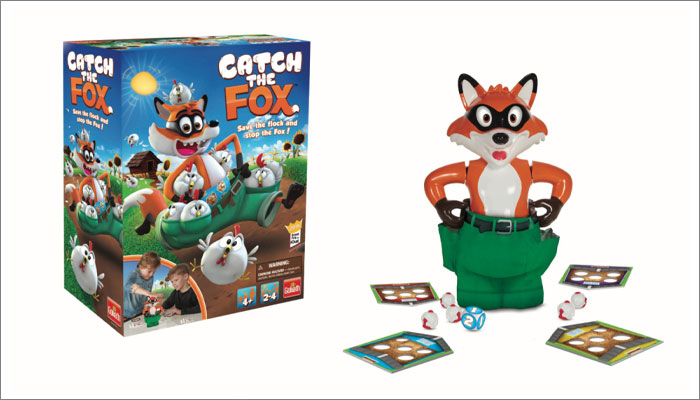
So, to clarify, when the fox’s pants vanish, they vanish in the same way that a magician might vanish a hanky? Because that really grabs me; that’s just fantastic… “What if you build a magician’s secret into a game?” Creatively, that’s a fascinating starting point!
And more importantly, we view toys as I did when I was a performer: it’s not the trick or the prop alone that creates magic… It’s the performance, the story or theme that sets you up for a ‘wow’ experience or a surprise.
Absolutely. I often say, “Every successful magician is a magician second” because successful magicians are usually an actor first, or a comic, or a storyteller. Without the other part – the original presentation – the tricks are just tricks…
Right. And as a magician, I always tried to show the audience something they hadn’t seen before. I mean they may’ve seen the mechanism before, but not the way I presented it. For example, the Siegfried & Roy award you mentioned… I was fortunate; I wasn’t the most talented technical performer, but I was able to surprise and delight. This is the real magic! Now, for each product and promotional effort, our team strives to apply this thinking.

What’s the appeal of magic, do you think?
It’s the “wow” experience! It makes everyone happy, including me. I love to make people engage in that and, as a magician, you spend your time trying to create wonderful and impossible situations to turn into amazing acts of magic. That’s the mindset! When we work on toys and games, we work so hard to find the right “impossibles” to create the experience of the “possible.”
Great! You know, this might be something we cut because I’m just going to indulge myself a moment: as a magician, which effect is closest to your heart?
The Artist’s Dream type effects…
Okay: the plot being that an artist dreams about a 2D picture coming to life… So it might be that a portrait of a woman comes to life before she vanishes in an beautiful way…
Yeah; it’s a really old idea… But an interesting plot. So I invented a trick based on this many years ago. I interacted with a TV screen – this is before flat screens were a thing… I’d reach into the screen’s video and pull out objects: a screen-to-life effect. This type of effect is what I strive to achieve when working in the toy-and-game industry: bring to life things that we see and imagine in a new form.
Superb! Alright, let’s broaden it out. Which five tips would you give every new inventor?
One… Ideate lots, and invent lots and lots of ideas. Two: pitch, pitch and pitch with thick skin. No single idea is too precious – there’s no crying in baseball and toy inventing. Three… Go back to phase one and keep doing it until something works – royalties are for closers. Four: Don’t count your money until it’s in the bank and five, when times are good, save, save and save to last until your next big hit.
You mention having a thick skin when pitching… What else makes a great pitch?
Big question. A defined position that grabs the audience; the idea and the whitespace or trend that you see your product filling in the marketplace… And a solid prototype that won’t fall apart in their hands! You have to make sure they can actually play with it.
There’s three corkers – and you’ve not even broken sweat!
No, there’s more! A compelling sizzle video that reveals the thematic and opportunity. Also, have fun and create fun during the pitch! Don’t pitch as if your life depends on the deal, even if it does. And finally, be polite yet assertive with follow up. Don’t drive them crazy.
Wow. This is just great! Thank you. We’re going to have to wrap it up but let’s do two more! Okay… If you were to write your autobiography, what would you call it?
My Magical World.
Perfect. Finally, Jim, what’s the most interesting thing in your office?
Wow! There are so many crazy items in there… I have a special spot in my heart for a nine-foot animatronic bear named Sparx, though. Sparx sits not far from my desk… If I ever need inspiration, he’s always eager to offer sage advice!
Animatronic bear named Sparx; of course! Might’ve known… Jim, this has been a genuine pleasure – and all done by kindness; thank you so much!
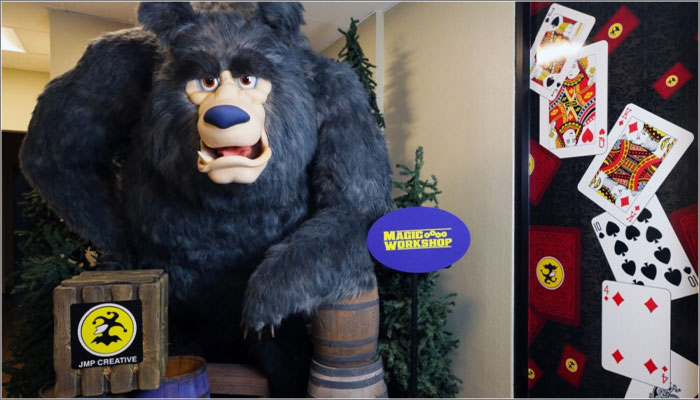
—-
To stay in the loop with the latest news, interviews and features from the world of toy and game design, sign up to our weekly newsletter here





